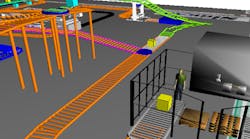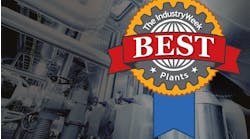Achieving Lean Manufacturing through Lean Design
To remain competitive, manufacturers must utilize "lean manufacturing" — operating with maximum productivity and process efficiency, while generating quality products. Although establishing processes that support the lean manufacturing philosophy can be a challenge, finding improvements to those processes, with a reasonable return on the investment, is often the greater challenge.
Manufacturers should utilize methods such as process simulation modeling, achieving the manufacturing edge by using experienced process engineers who apply simulation techniques. Preserving value with less work can be accomplished through "lean" methods of design and problem solving.
Preserving Value with Less Work
Using a "lean design" approach, process simulation experts can analyze and suggest improvements much more quickly than someone using traditional techniques.
Utilizing process simulation (an analytical approach to modeling industrial and manufacturing processes), the engineer scrutinizes the tasks of the process flow — separately, concurrently or in conjunction with other processes and procedures — to understand the data and to determine problem resolution and better practices.
Analysis of materials, operations, handling and time factors can show the bottlenecks. Adjustments can then be made to the model, at which time the effect on the entire process is observed — often with surprising results.
Reducing Work in Process Inventory
Identifying and resolving the correct root cause of problems with distribution techniques, which have direct impact on Work in Process (WIP) inventorylevels, will reduce those levels.
Process modeling techniques, used with other techniques like root cause analysis, can identify and resolve inventory level issues.
For example, a manufacturer of original automotive equipment and after-market parts was experiencing increasing expense due to anomalies in their WIP process.
Consultants using traditional analysis of the operations recommended technically advantageous, but extensive, renovations to the plant. That approach yielded an ROI of more than two years, which was far longer than the manufacturer was willing to accept.
However, when other consultants utilized process simulation to perform the same analysis, the manufacturing bottlenecks were easily located.
The consultants' recommendation was simply to relocate the loading docks to points adjacent to where materials are used, without having to move major equipment.
The solution eliminated so much material handling that worker productivity increased more than 20% and yielded an ROI of less than one year.
Enhancing the Production Line Efficiency
Process modeling can quickly and accurately determine the right manufacturing productivity enhancements to a product line, which will cost-effectively reduce errors and waste, and improve quality.
For example, an automotive plant in Ohio made 122 versions of rear wheel transmissions. Final assembly lines were fed sub-assemblies from various other sub-assembly lines.
However, after installing two new final assembly lines, the plant was failing to achieve production numbers, operating at 60–70% efficiency and experiencing a 27% rejection rate.
Specifications, drawings, process diagrams and standard operating procedures were studied. The analyst discovered the most impactful inefficiency to be that no completed work was transported until all stations were complete.
The system was reprogrammed to transport work upon completion, and a new program was created at each station, removing the transport time from the cycle time.
Production increased from 700 to 1,000 per shift per line, at 83% of utility.
The next round of analysis through process modeling and root cause analysis revealed bottlenecks at the line-to-line transfer points. Removing the bottlenecks increased productivity to 97%.
Getting the last 3%, to achieve 100% utility at 1,200 per shift per line, came with considerable work to enhance the "intelligence" of the system, but was accomplished through experience, teamwork, creative solutions and innovative spirit.
"Perfect shifts" were the result, with final assembly lines meeting 100% of the production schedule at full 100% utility, and with the additional achievement of complete flexibility and increased quality control. Any of the 122 models could be built on the line at the same time with automated part selection and placement monitoring. Because the final assembly lines were so productive, the sub-assembly lines could not keep up, so the same analytical techniques and successes were applied to those lines as well.
The rejection rate dropped to 0.5% or less, for years following, making the plant the most productive in the USA. The ROI was measured in weeks, not years, with an estimated increase in the manufacturer's revenue of $192 million per year.
Simplifying Worker Tasks to Increase Production
Simplifying worker tasks does not require relocating major equipment. In fact, doing so often creates a domino effect, with modified foundations or pits, significant structural reconstruction or additions to a building. It also pushes the ROI well beyond comfortable timetables.
However, simulation modeling can lead to increased production and significantly shortened ROI. For example, an automotive manufacturing plant that produced 200 vehicles per day using two shifts wanted to increase production without costly reconstruction.
A 300-vehicle-per-day simulation, created by FlexSim Simulation Software, showed that it could be achieved, with one shift, creating an immediate cost savings.
Simplifying worker tasks proved to be the most effective method to increase productivity. Parts required by workers were placed in a basket that travelled with each vehicle along the line. Each workstation was equipped with a verification screen that allowed each worker to check off the task performed.
In an innovative step, telescoping stations were added, allowing workers to raise or lower a vehicle to allow easier access to particular areas. Basic ergonomic solutions like these significantly decreased the time required to install each part.
Simulation Skill is Achieved by Experience
While process simulation has its historic roots in the chemical industry, the basic theory — describing each step mathematically and then making adjustments to increase productivity — is applicable to nearly any manufacturing process.
Like any tool, the experience of the professional who has used it makes all the difference. Achieving the highest possible efficiency within a computer model is relatively easy; assessing changes to a manufacturing line while keeping cost, feasibility and ROI goals in line is entirely another exercise. An experienced engineer's talent lies in this practical, cost-effective approach to process design and analysis.
The advantage of lean manufacturing by lean design is clear — various changes and options to a manufacturing process can be examined virtually, without the tremendous expenditure of reconfiguring the manufacturing line or purchasing new equipment. In the hands of a talented engineer, these findings translate into cost-effective improvements with maximum impact on productivity.
The use of process simulation modeling software warrants lean design. Lean design leads to lean manufacturing. Lean manufacturing impacts the bottom line and propels manufacturers to leader positions in their industry.
Authors are with SSOE Group (www.ssoe.com), an international engineering, procurement and construction management firm. With 23 years' experience, Ron Guiliani, PE, PMP, is a senior vice president, specializing in Industrial Manufacturing and R&D projects. Tim Bolbach, PE, is a master engineer with 34 years' experience and responsibility for leading teams of highly skilled engineers in the design of state-of-the-art automation and instrumentation systems for process and machine control.




